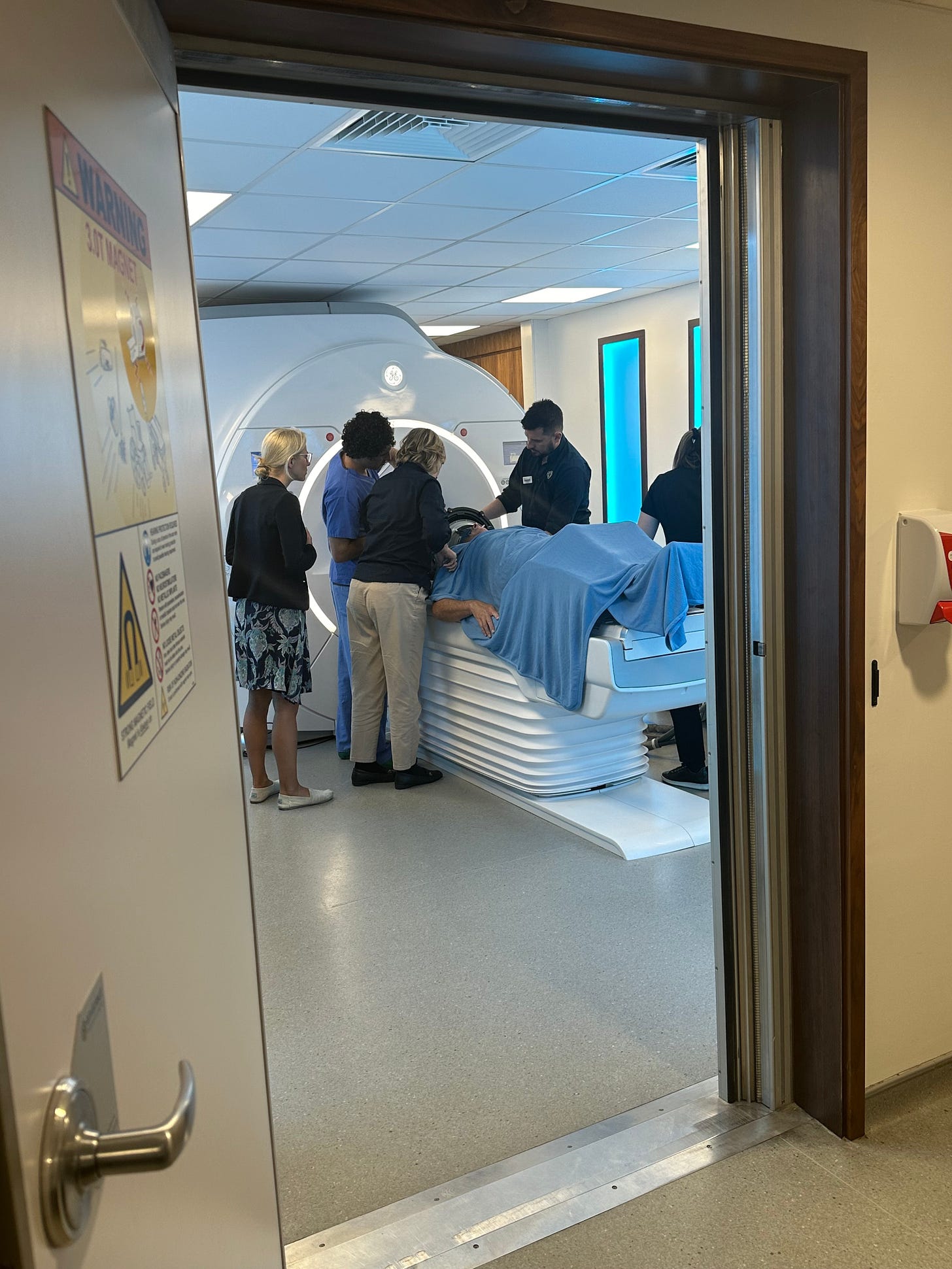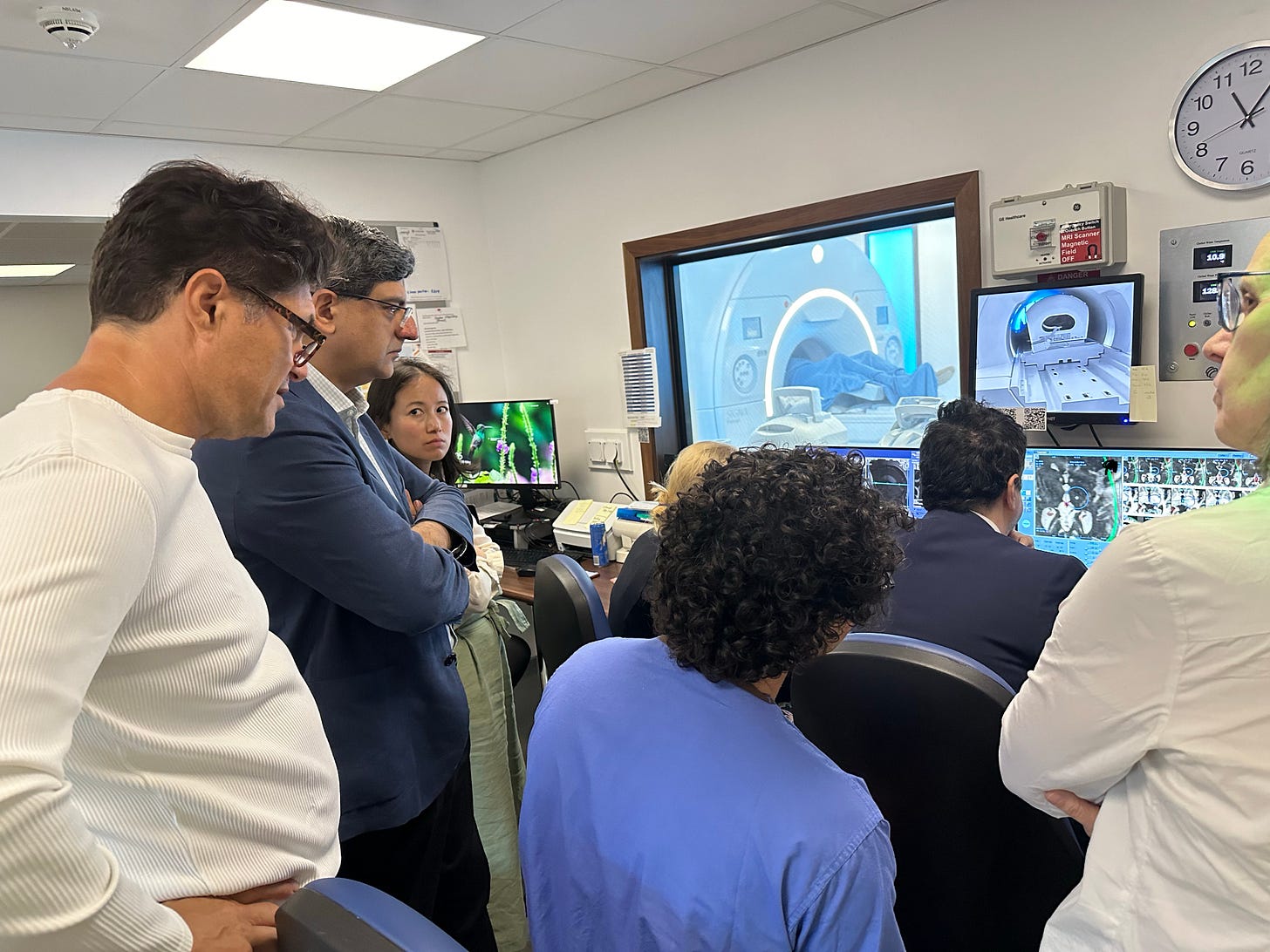Over the last 18 months Movers and Shakers has benefitted from the input of some of the UK’s most brilliant neurologists who we now think of as friends of the podcast, people we can lean on for advice as well as for interviews.
One such is Professor Ludvic Zrinzo, who featured on an early episode about Deep Brain Stimulation (DBS) where his passion for his work and his excellent communication skills shone through. So when Professor Zrinzo got in touch back in May, excited about a new therapy for Parkinson’s I was excited to hear more.
What he was talking about was something called focused ultrasound an ultrasound device guided by an MRI scanner to treat areas of the brain responsible for various conditions including Parkinson’s. And the professor wasn’t underselling it: ““I don't say this lightly, DBS was the biggest surgical innovation for Parkinson's, and I think this is the next big thing.”
At his invitation I went to see a focused ultrasound operation at London’s Queen Square Imaging Centre and cane away impressed with what felt more like a space mission than a surgical intervention. Professor Zrinzo and his team wore their normal clothes rather than scrubs and spent most of their time in a control room where through glass they could see the patient being manoeuvred into an MRI scanner.
He stayed there for two and a half hours while engineers went through meticulous preparations to zero in on the tiny area of the brain that was to be “cooked.” Afterwards, the first patient of the day, who was being treated for essential tremor rather than Parkinson’s, demonstrated that a simple task that had become impossible - drinking a glass of water - had become simple once more.
When he came to the pub a few months later to record this episode of the podacst, Professor Zrinzo gave us an in depth explanation of what. focused ultrasound is all about and how it compares to DBS:
“Just as in the same way we're using deep brain stimulation to alter how brain circuits control movement, we can use tiny little burns in the brain to alter circuits that are malfunctioning and causing symptoms like tremor, like slowness, like rigidity, like dystonia.”
Weighing up the decision for a patient between DBS and ultrasoound he said there were pros and cons to both:
“The pro about DBS, is that you can have it done all asleep these days, so you don't need to be awake. WIth a focused ultrasound we really want to make sure we're in the right spot, so we like doing this on people under a local anaesthetic. It's what we call an incisionless procedure. You don't need a scalpel.”
But he said focused ultrasound, which is not widely available on the NHS, would be more attractive to patients who wanted just one operation rather than the repeated adjustments that are a feature of DBS:
“I think living without wires inside your brain, without electrodes, without batteries, without the need for multiple visits to see the neurologist, without programming sessions, I think that may be a potential plus.”
We also heard from Ian King, the 70 year old retired painter and decorator who had been the second person to receive the ultrasound treatment on the day of my visit. His Parkinson’s had given him such a violent tremor on one side of his body that he was just embarrassed to be seen in public. It had meant severe curbs on his social life, including stopping him from enjoying golf which he used to pl;ay frequently with friends. “My life just finished,” he said.
But the ultrasound operation changed all that. Having a cage fitted to his head and spending so long in the MRI scanner had been a bit of an ordeal, “but it was well, well worth it.” A few months on, he said, he was “back to normal”, out and about socialising and enjoying himself - and yes, even playing golf.
One leading neurologist, however is not convinced that focused ultrasound could or should become the new DBS. Professor Keyoumars Ashkan, professor of neurosurgery at King’s College Hospital, emphasised that while we might see ultrasound as less invasive than DBS that was not the case. Unlike DBS it involved the destruction of part of the brain and that had some downsides:
“If you burn the wrong part of the brain, you can cause all sorts of problems, paralysis, brain swelling, etc.”
Professor Zrinzo said focused ultrasound certainly had its place and might be suitable for some patients but it was not the future of DBS - that was better DBS.
“DBS is adjustable. You can titrate the treatment to the needs of the patient. Nowadays, we can even personalise the treatment.”
We. end by discussing whether we fancied having an ultrasound machine burn a tiny hole in our brains rather than having electrodes inserted into us. For Gillian Lacey-Solymar and Paul Mayhew-Archer the question is academic - once you have had DBS, ultrasound is not an option. But the rest of us were quite excited about ultrasound, perhaps because the persuasive Professor Zrinzo was with us in the pub while the more sceptical Professor Ashkan was on tape.
Listen out for a couple of other items. At the end of the episode there is an update on the Parky Charter from Gillian with an interview with a taxi driver angry at the poor treatment is father has had since being diagnosed with Parkinson’s. This is why the charter is so important to us.
And on a lighter note, we begin with a discussion of Judge Nick Mostyn’s problems with his left buttock and the remedy he has found for them. Don’t say that Movers and Shakers does not give you a varied diet.





This all sounds very exciting, I'm looking forward to hearing the next episode of Movers and Shakers.
Thank you for introducing focused ultrasound to me. I live in Washington DC and will research whether the procedure is available here.